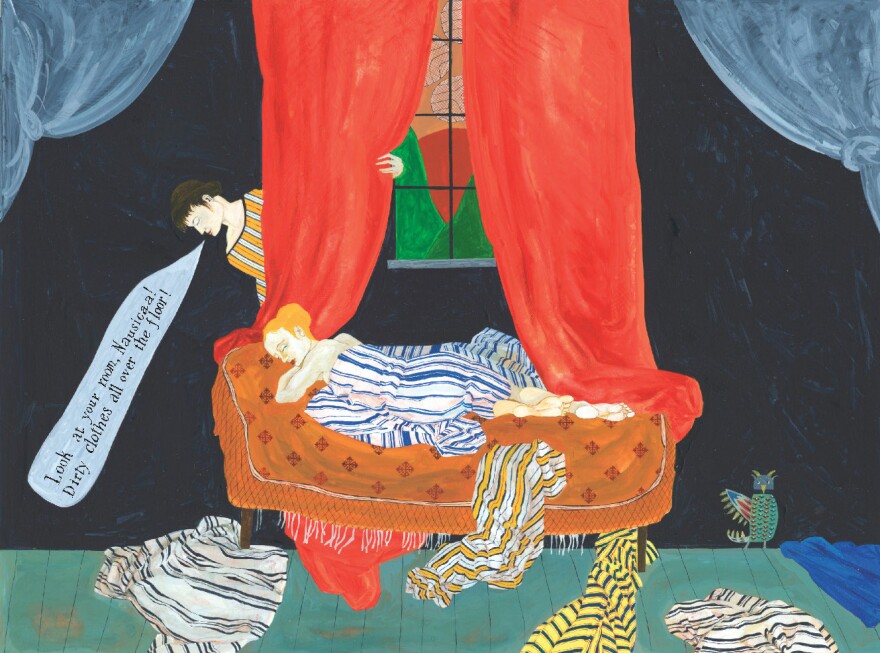Most people who read a lot have gotten used to reading on a screen, whether it's a laptop, a tablet or an e-reader. Some say they prefer it to the experience of reading a heavy, awkward print version of the book. But every now and then, a book comes along that just seems to insist on being physical — something about it simply can't be transferred to the screen.
Gillian Cross' new retelling of Homer's The Odyssey is aimed at kids 8 and up, and like many children's books, it's brightly colored and beautifully illustrated. But the artwork in this book — illustrated by Neil Packer — seems sophisticated for a kids' book. These are not your standard depictions of gods and goddesses with chiseled features in flowing gowns. The images are stylized, multilayered, richly colored and a little edgy. It seems like a book that might appeal to adults as well as children — a perfect book perhaps to read with a child. Would a book like this ever make sense as an e-book?
"We feel that the book is a nearly perfect technology as it is, and that is why it's been around for so long," says Karen Lotz, president and publisher of Candlewick Press — the publishing house that released The Odyssey in the U.S. Candlewick specializes in children's books, and like all publishing companies, it now releases books in both electronic and traditional book form. But Lotz says some books — The Odyssey among them — seem destined for print. That decision, she says, is made at the beginning of the publication process.
"If you're thinking about a book in its early stages, you're almost always imagining what it's going to be like and what it's going to feel like," Lotz explains. "And I think we're coming into a time where we as publishers do that digitally as well. We think about something in a digital form. But if it's going to insist on being physical, it means it's going to be lavish, beautiful, tactile, something to linger over."

Lotz says at Candlewick they strive to make every book beautiful, but a few fall into a category they think of as their "specials" line. These are books that might make good gifts or that they imagine will have a long life on someone's library shelf. A team of editors, art directors and designers lavish attention on these books, paying close attention to every detail during production.
"We're all obsessed actually with books, with paper, with paper quality," Lotz says. "We've gone so far on certain of our titles to invent colors that never existed before. ... That's the type of detail that we're into. We love working with the artist and figuring out what their dream would be of the ideal form, and that kind of collaboration is incredibly exciting."
Neil Packer, the artist behind The Odyssey, has also illustrated collectors' editions of well-known novels including Catch-22 and One Hundred Years of Solitude. Packer says he began working on The Odyssey six years ago, well before most people had even heard of e-books.
"It was very much conceived, obviously, as a tactile and physical thing," Packer says. "I work pigment on paper — that's how the thing starts, and that's probably how they are best represented. For me, I like the tactility of the book and that fact that one can have it as on object of beauty, almost an ornament."

Packer says he would be interested in exploring what he could do with digital technology, but he believes if a book is going to be viewed on screen, the artwork needs to be conceived that way. He says transferring artwork from the pages of a book like The Odyssey to an electronic device doesn't really work.
"I don't think turning it into an electronic book would actually do anything to it; it wouldn't bring anything to it," he says. "The problem is with picture books, when you put them on a screen, they sit there rather awkwardly. They don't actually do anything. I think the temptation for publishers then is often to add animation to them and open up discussion forums and that sort of thing — again, it doesn't ... take them anywhere."
Of course, illustrations alone do not make a book, especially a book like The Odyssey. "The book was conceived as a whole, words and pictures together — they're not separable," says writer Gillian Cross.
Cross wrote this version of The Odyssey for children. She views the book as a stepping stone, a way in for young people who are likely to read the original when they get older. Cross says she can't imagine The Odyssey in e-book form.
"I have known all along it would be impossible for it to be an e-book with the current state of the technology," Cross says. "There's no way the technology could cope with what the pictures are, with their richness and their vitality."
Cross has nothing but admiration for Packer's artwork, but she does disagree with him on one point: The beauty of a book is one reason to treasure it, she says, but a book should be viewed as more than a work of art that sits on a shelf. If it is regarded as nothing more than an ornament, she worries it will be marginalized, and readers of the future will never understand all that a physical book offers.
"With anything digital, even upon your e-reader, there will be another book, or on the Internet there will be another link you can click on," Cross says. "The fact that a printed book invites you to close it, and that it has been specially designed so that the shape of it might be unique — the shape of The Odyssey is quite interesting, isn't it? And the weight of it in your hands — all these things I think have value in that they invite you to reflect on what's inside the book."

Not all books are the same. Some, like encyclopedias and paperbacks we pick up while traveling navigate easily to the screen. But some books hold a special place in our hearts. Often, says Karen Lotz, they are the books we first encountered as children.
"People tend to remember the books that they had when they were children as physical objects," Lotz says. "They remember what the book felt like in their hand, where it sat in their room, they take it under the covers at night, they take it outside to read under a tree. It's a very precious object, it gets some power over us as we read it, it sort of becomes part of us and we become part of it in a very interesting way."
The technology of e-books is still developing, says Lotz. Eventually it may be possible to reproduce visually rich, highly designed books onto a screen in a way that is as satisfying as a physical book. But even when and if that day arrives, Lotz believes there will always be a place for both — and perhaps there will always be books that just don't need to go digital.
Copyright 2023 NPR. To see more, visit https://www.npr.org.




